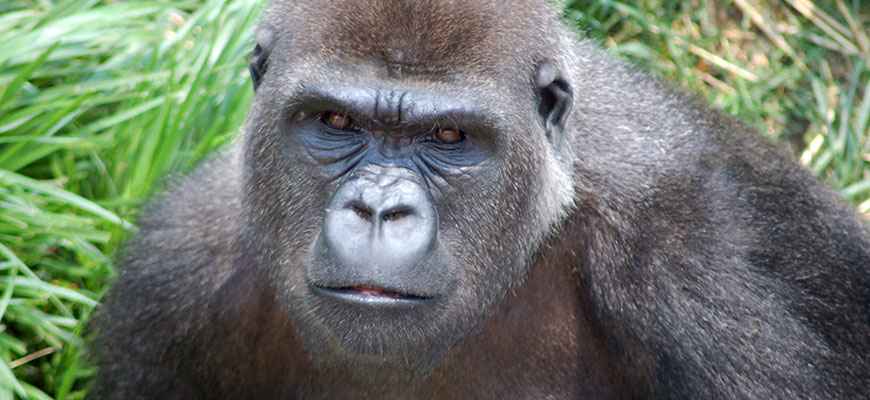RANGE
There are two species of gorillas, each with two subspecies, inhabiting four small separate regions in Africa. Western gorillas, including western lowland and cross river gorillas, are found in west central Africa, between the Congo and Niger rivers, with cross river gorillas only found in an isolated 290 square mile area in Nigeria and Cameroon. Eastern gorillas, including eastern lowland and mountain gorillas are found in the Democratic Republic of Congo, Uganda and Rwanda, with the eastern lowland gorillas found in the lowlands of the Democratic Republic of Congo, while mountain gorillas occupy only the high altitudes of the mountain forests in the chain of the Virunga volcanoes.
HABITAT
Western and Eastern lowland gorillas and cross river gorillas live in lowland rainforest
areas, and will venture into forest clearing wetland areas called “bais”. Mountain gorillas are found in cooler cloud forests at high altitudes.
SIZE
Males: average height — about 5 ½ feet. Average weight — about 400 pounds
Females: average height — about 4 ½ feet. Average weight — about 200 pounds.
DIET
Wild: mainly vegetation — known to eat about 200 different species of plants —
leaves, stems, fruit, flowers, shoots, bulbs.
Zoo: a variety including kale, celery, lettuce, apples, melon, corn, sweet potatoes,
bananas, primate biscuits, seeds, nuts, raisins
REPRODUCTION
- Females reach sexual maturity at 7 – 8 years of age, but normally will not breed until several years later. Males reach sexual maturity about 11 – 13 years, but normally do not father offspring until they reach silverback status and have a family group of their own (about 15 – 20 yrs of age).
- Gestation: 8 ½ months. Baby gorillas weigh an average of 4 pounds. Newborns are basically helpless, but can cling to the mother.
- Development is rapid. Females care for young for several years, and will not mate while nursing — a period of 2 – 4 yrs.
BEHAVIOR
- Gorillas live in family groups of anywhere from 2 – 20 individuals. The silverback is the dominant, mature male. He makes decisions concerning where and when to eat and sleep, and protects the family from danger. He has the reproductive privileges with the adult females. Young adult males are called blackbacks, and will leave their birth group to eventually start a family group of their own. Non-related adult females are part of gorilla groups. Females leave their birth group at puberty and establish new bonds elsewhere. Youngsters and infants round out the family group.
- Gorillas spend much time each day finding and eating food. They often take time to rest in the afternoon, before they continue looking for food. At night they will stop and build nests on the ground or in trees.
- Gorillas communicate with each other through a wide variety of sounds, facial expressions, gestures and scents. Generally they lead a very peaceful existence.
POINTS OF INTEREST
- Gorillas normally walk on all fours with the front knuckles of their hands curled under to support their weight (knucklewalking).
- Their thumbs and big toes are opposable.
- Gorillas can be identified individually by their unique noseprints (the shape of the nostrils and the pattern of crinkles on the bridges of their noses).
- Gorillas have a pot-bellied appearance. They have a huge abdomen to accommodate the large intestines necessary to digest all the bulky, fibrous food they eat. An adult may eat 40 – 50 pounds of food per day.
- The high, bony ridge on top of the gorilla skull is called the sagittal crest. The powerful jaw muscles attach to this area. It is quite prominent on the males.
STATUS
All four subspecies are endangered. Recent data show the number of Western lowland gorillas to be about 100,000, Eastern lowland gorillas about 17,000, and mountain gorillas about 700 and cross river about 300.
REFERENCES
- The Encyclopedia of Mammals. Edited by Dr. David MacDonald, Barnes&Noble Books 1999.
- The Behavior Guide to African Mammals by Richard Despard Estes, Univerversity of California Press, 1991.
- Beastly Behaviors by Janine M.Benyus, Addison Wesley Publishing Company, 1992.
- Gorilla: A Vanishing Species — A Student Guide to Environmental Activism by KarenWilliams, M.S., The Creative Company, Richard Ruerwein, 1993.
- ZOOBOOKS: Gorillas by John Bonnett Wexo, Wildlife Education, Ltd., 1991.
- Gorillas- the greatest apes by Michael Bright, Dorling Kindersley, 2000
- Primate Info Net http://pin.primate.wisc.edu/factsheets/entry/gorilla







